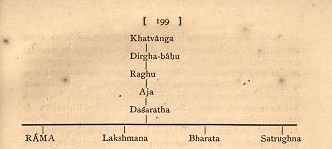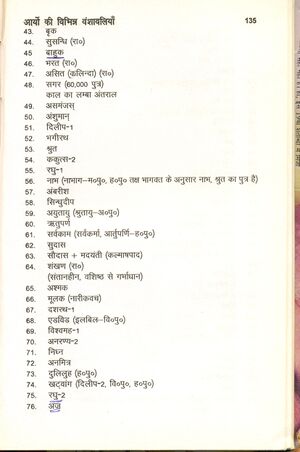Raghu
Raghu (रघु) was a Suryavanshi king of the Ikshvaku dynasty. Raghu is best known today as the great-grandfather of Rama.
Jat Gotras from Raghu
Raghuvanshi (रघुवंशी) - Raghuvansi gotra Jats live in Muzaffarnagar, Meerut districts in Uttar Pradesh and Jaipur district in Rajasthan. They are descendants of Maharaja Raghu (रघु).[1]
The lineage

A number of Puranas, which include the Vishnu Purana, the Vayu Purana, the Linga Purana, mention Dirghabahu as the son of Dilipa and Raghu as the son of Dirghabahu. But the Harivamsha, the Brahma Purana and the Shiva Purana mention Raghu as son of Dilipa and Dirghavahu as his epithet.[2] The lineage described in the Raghuvamsha mention Dilipa as the father of Raghu. According to the Raghuvamsha, he was born to king Dilipa-2 and his queen Sudakshina. The lineage described in the Raghuvamsha mention Dilipa as the father of Raghu. According to most of the Puaranas, as well as Kalidasa, Raghu was succeeded by his son Aja, who was the father of Dasharatha, the father of Rama, Lakshmana, Bharata and Shatrughna.
According to Bhagavata Purana The ancestry of Raghu is as under:
Khatvanga (खट्वांग) → Dirghabahu → Raghu → Aja → Dasharatha → Rama + Lakshmana + Bharata + Satrughna

Life of Raghu
The warrior Raghu Gopal leads a military expedition to Transoxiana. He defeats and subjugates local peoples along the way (presumably on his march through Central Asia) until he reaches the Vankshu or Caksu, the Vedic/Puranic names of the Oxus River. There, Raghu's army battles the Hepthalites, or White Huns, whom the Indians called Hunas and Mlecchas (barbarians). The Hepthalites are defeated, and the Raghuvamsha boasts of "The exploits of Raghu, whose valor expressed itself amongst the husbands of the Huna women, became manifest in the scarlet color of their cheeks."
Raghu was a great donor. It is said that no one returns from his palace empty-handed.
After crossing the Oxus, Raghu and his army encountered the Kambojas, an ancient Iranian people often mentioned in Indian texts. The Kambojas submitted to Raghu and offered him gifts and treasures. Evidently, the Kambojas dwelt in the vicinity of the Pamirs. Kalidasa describes the preponderance of walnut trees in the Oxus country and indeed, this particular region is still known for the cultivation of walnuts.
Raghu's father Dilipa was a very pious king, and performed as many as 100 yajnas or sacrificial rituals. Until he did so, only Indra, king of the Gods, had earned that distinction. In a bid to prevent Dilipa from equalling his record, Indra placed many hurdles in the path of the successful completion of the 100th sacrifice, but Raghu was able to prevail over the forces of Indra himself, and the sacrifice was completed successfully.
Raghu is best known today as the great-grandfather of Rama. There are indications that in the classical period, Raghu was a heroic personality of far greater importance that what one would imagine today. The mahakavya (epic) composed by the classical poet Kalidasa on the lives of the ancestors of Rama is entitled Raghuvamsha or the "Dynasty of Raghu". Indeed, Rama himself is known by many appellations (such as Raghava, Raghunandan and Raghukula Nayaka), indicative of his belonging to the family of Raghu, which again serves to underscore the great prestige enjoyed by Raghu in the puranic era.
पारस
विजयेन्द्र कुमार माथुर[3] ने लेख किया है ...पारस (AS, p.549) ईरान या फारस का प्राचीन भारतीय नाम है. पारस निवासियों को संस्कृत [p.550]: साहित्य में पारसीक कहा गया है. रघुवंश 4,60 और अनुवर्ती श्लोकों में कालिदास ने पारसीकों और रघु के युद्ध और रघु की उन पर विजय का चित्रात्मक वर्णन किया है, 'भल्लापवर्जितैस्तेषां शिरोभिः श्मश्रुलैर्महीं। तस्तार सरघाव्याप्तैः स क्षौद्रपटलैरिव (4.63) आदि. इसमें पारसीकों के श्मश्रुल शिरों का वर्णन है जिस पर टीका लिखते हुए चरित्रवर्धन ने कहा है--'पाश्चात्या: श्मश्रूणि स्थापियित्वा केशान्वपन्तीति तद्देशाचारोक्ति:'अर्थात ये पाश्चात्य लोग सिर के बालों का मुंडन करके दाढ़ीमूछ रखते हैं. यह प्राचीन ईरानियों का रिवाज था जिसे हूणों ने भी अपना लिया था.
कालिदास को भारत से पारस देश को जाने के लिए स्थलमार्ग तथा जलमार्ग दोनों का ही पता था--'पारसीकांस्ततो जेतुं प्रतस्थे स्थलवर्त्मना । इन्द्रियाख्यानिव रिपूंस्तत्त्वज्ञानेन संयमी' (4.60)
पारसीक स्त्रियों को कालिदास ने यवनी कहा है--'यवनीमुखपद्मानां सेहे मधुमदं न सः । बालातपं इवाब्जानां अकालजलदोदयः (4.61)
यवन प्राचीन भारत में सभी पाश्चात्य विदेशियों के लिए प्रयुक्त होता था यद्यपि आद्यत: यह आयोनिया (Ionia) के ग्रीकों की संज्ञा थी. कालिदास ने 'संग्रामस्तुमुलस्तस्य पाश्चात्यैरश्वसाधनैः । शार्ङ्गकूजितविज्ञेयप्रतियोधे रजस्यभूथ् (4.62) में पारसीकों को पाश्चात्य भी कहा है. इस पद्य की टीका करते हुए टीकाकार, सुमिति विजय ने पारसीकों को 'सिंधुतट वसिनो मलेच्छराजान्' कहा है जो ठीक नहीं जान पड़ता क्योंकि रघु. 4,60 में (देखें ऊपर) रघु का, पारसीकों की विजय के लिए स्थलवर्त्म से जाना लिखा है जिससे निश्चित है कि इनके देश में जाने के लिए समुद्रमार्ग भी था. पारसीकों को को कालिदास ने 4,62 (देखें ऊपर) में अश्वसाधन अथवा अश्वसेना से संपन्न बताया है.
मुद्राराक्षस 1,20 में 'मेधाक्ष: पंचमो-अश्मिन् पृथुतुरगबलपारसीकाधिराज:' लिखकर, विशाखदत्त ने पारसियों के सुदृढ़ अश्वबल की ओर संकेत किया है. कालिदास ने प्राचीन ईरान के प्रसिद्ध अंगूरों के उद्यानों का भी उल्लेख किया है--'विनयन्ते स्म तद्योधा मधुभिर्विजयश्रमं । आस्तीर्णाजिनरत्नासु द्राक्षावलयभूमिषु (4.65).
विष्णु पुराण 2,3,17 में पारसीकों का उल्लेख इस प्रकार है-- 'मद्रारामास्तथाम्बाष्ठा:, पारसीका दयास्तथा'.
ईरान और भारत के संबंध अति प्राचीन हैं. ईरान के सम्राट दारा ने छठी सदी ईसा पूर्व में पश्चिमी पंजाब पर आक्रमण करके कुछ समय के लिए वहां से कर वसूल किया था. उसके नक्शे-रुस्तम तथा बहिस्तां से प्राप्त अभिलेखों में पंजाब को दारा के साम्राज्य का सबसे धनी प्रदेश बताया गया है. संभव है गुप्त काल के राष्ट्रीय कवि कालिदास ने इसी प्राचीन कटु ऐतिहासिक स्मृति के निराकरण के लिए रघु को पारसीकों पर
[p.551] विजय का वर्णन किया है. वैसे भी यह ऐतिहासिक तथ्य है कि गुप्त सम्राट महाराज समुद्रगुप्त को पारस तथा भारत के पश्चिमोत्तर अन्य प्रदेशों से संबद्ध कई राजा और सामंत कर देते थे तथा उन्होंने समुद्रगुप्त से वैवाहिक संबंध भी स्थापित किए थे. आठवीं सदी ई. के प्राकृत ग्रंथ गौडवहो (गौडवध) नामक काव्य में कान्यकुब्ज नरेश यशोवर्मन की पारसीकों पर विजय का उल्लेख है.
References
- ↑ Dr Mahendra Singh Arya, Dharmpal Singh Dudee, Kishan Singh Faujdar & Vijendra Singh Narwar: Ādhunik Jat Itihasa (The modern history of Jats), Agra 1998, p. 279
- ↑ Misra, V.S. (2007). Ancient Indian Dynasties, Mumbai: Bharatiya Vidya Bhavan, ISBN 81-7276-413-8, pp.239-40
- ↑ Aitihasik Sthanavali by Vijayendra Kumar Mathur, p.549-551
Back to The Ancient Jats
